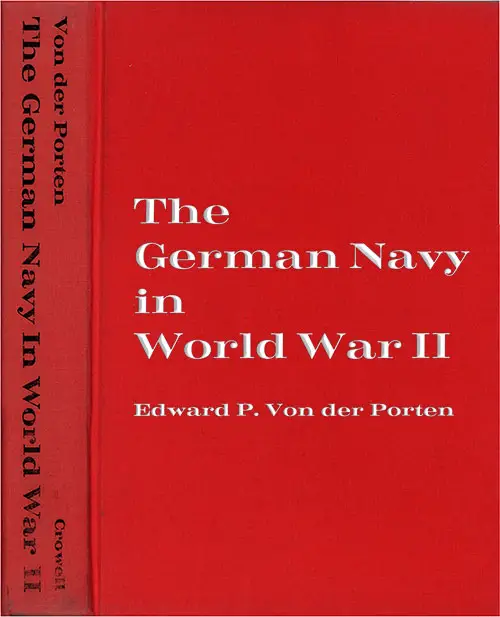The German Navy in World War II

Front Cover, The German Navy in World War II by Edward P. Von der Porten, 1969. GGA Image ID # 17ef8efdc8
The German Navy in World War II by Edward P. Von der Porten with a Foreword by Grand Admiral Karl Donitz. Published: Thomas Y. Crowell Company, New York. 1969 First Edition. 40 b&w photographs, 274 Pages.
Synopsis
The author traces the development of the new Navy during the prewar years, describing the secret building programs that contravened the Treaty of Versailles and the struggles over a policy that determined the new Fleet's size and composition when war broke out.
The book points up the problems, failures, and successes which were experienced in the commerce. raiding campaign of the auxiliary cruisers and capital ships; in Admiral Karl Doenitz's organization and execution of the U-boat campaign against the Allies; in the worldwide operations of a navy with limited access to the high seas; in operations with limited external support facilities; and in fighting an acknowledged more powerful British Navy.
Review by the US Naval War College
In The German Navy in World War II, Edward P. Von der Porten presents a broad, accurate view of German naval strategy employed during World War II.
The author stales that the period from the scuttling of the Imperial High Seas Fleet in Scapa Flow on 21 June 1919 until construction started on the battle cruiser Deutschland in 1928, was one devoted to reorganizing the Navy and inquiring into the strategy for the future.
Operational problems which did not require extensive funds, such as minesweeping, coding, codebreaking, and long-range communications, were solved for the future German Navy. At the same time, a searching evaluation was made of German naval strategy.
Vice Admiral Wolfgang Wegener tore apart the strategy employed in World War I, staling that the concentration on the idea of battle which dominated late Imperial Navy thinking was a faulty reading of the international naval “bible,” Mahan's The Influence of Sea Power on History, Mahan stressed the battle to contest scalanes, but Grand Admiral von Tirpitz had stressed battle in his strategic world, the North Sea.
The die was east for a high seas strategy for the Navy in 1928 when the decision was made to construct a seagoing battle cruiser instead of a coastal monitor built to support the army.
The book points up the problems, failures, and successes which were experienced in the commerce raiding campaign of the auxiliary cruisers and capital ships; in Admiral Karl Doenilz's organization and execution of the U-boat campaign against the Allies; in the worldwide operations of a navy with limited access to the high seas; in operations with limited external support facilities; and in fighting an acknowledged more powerful British Navy.
There are many lessons for the student of naval strategy to learn from the German experience of World War II. The author warns that the threat posed to the Western sea power by the German Navy of 1939-1945 may well serve as a grim warning to the Atlantic community now.
Abromitis, W. and Von der Porten, Edward P. (1970) "The German Navy in World War II," Naval War College Review: Vol. 23 : No. 2 , Article 15.
Library of Congress Catalog Listing
- LC Control No.: 69018674
- Type of Material: Book (Print, Microform, Electronic, etc.)
- Personal Name: Von der Porten, Edward P.
- Main Title: The German Navy in World War II [by] Edward P. Von der Porten.
- Published/Created: New York, T. Y. Crowell [1969]
- Description: ix, 274 p. illus., maps, ports. 24 cm.
- Notes: Bibliography: p. 257-265.
- Subjects: Germany. Kriegsmarine --History. World War, 1939-1945 --Naval operations, German.
- LC Classification: D771 .V65
- Dewey Class No.: 940.545/9/43
